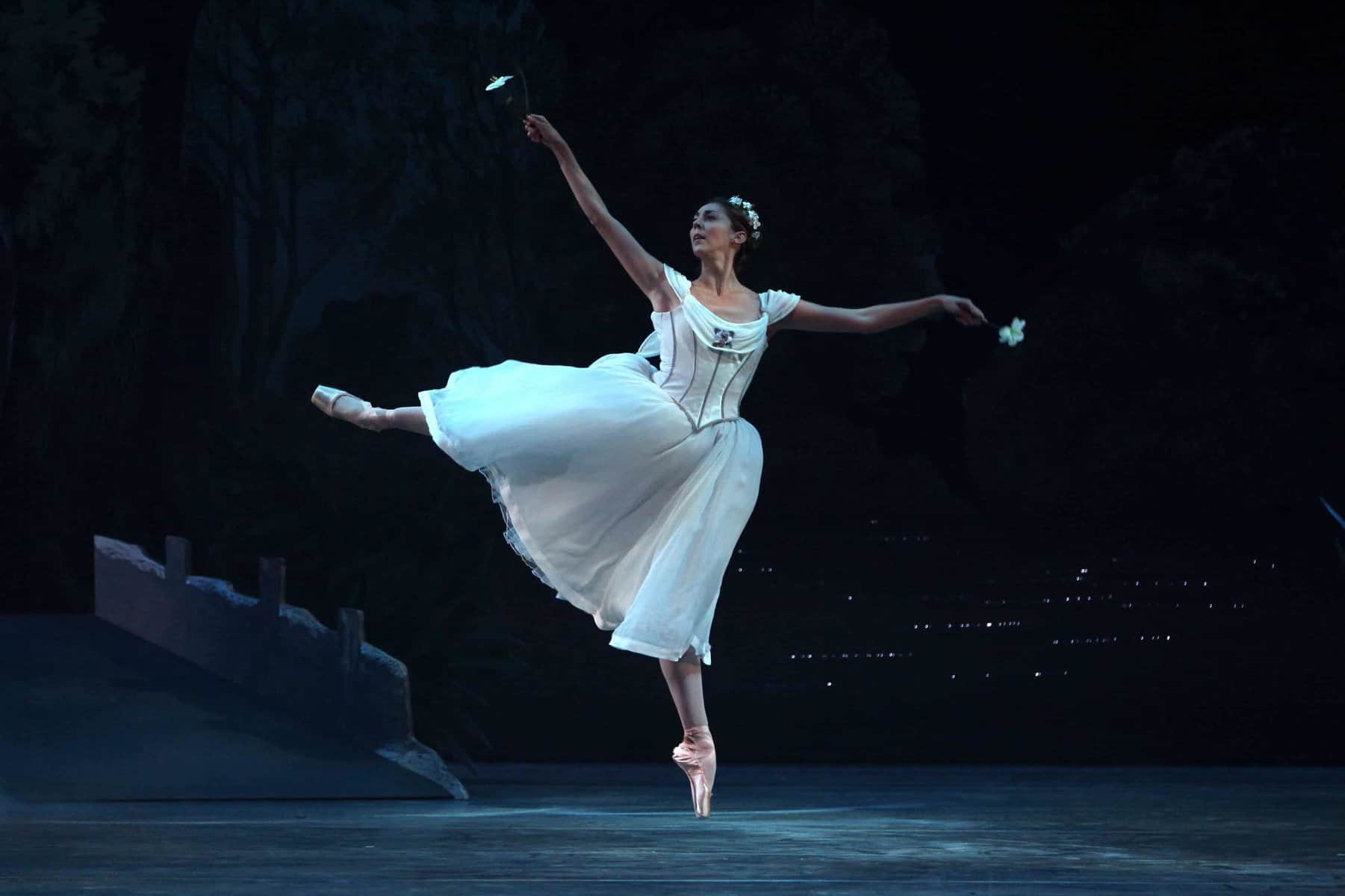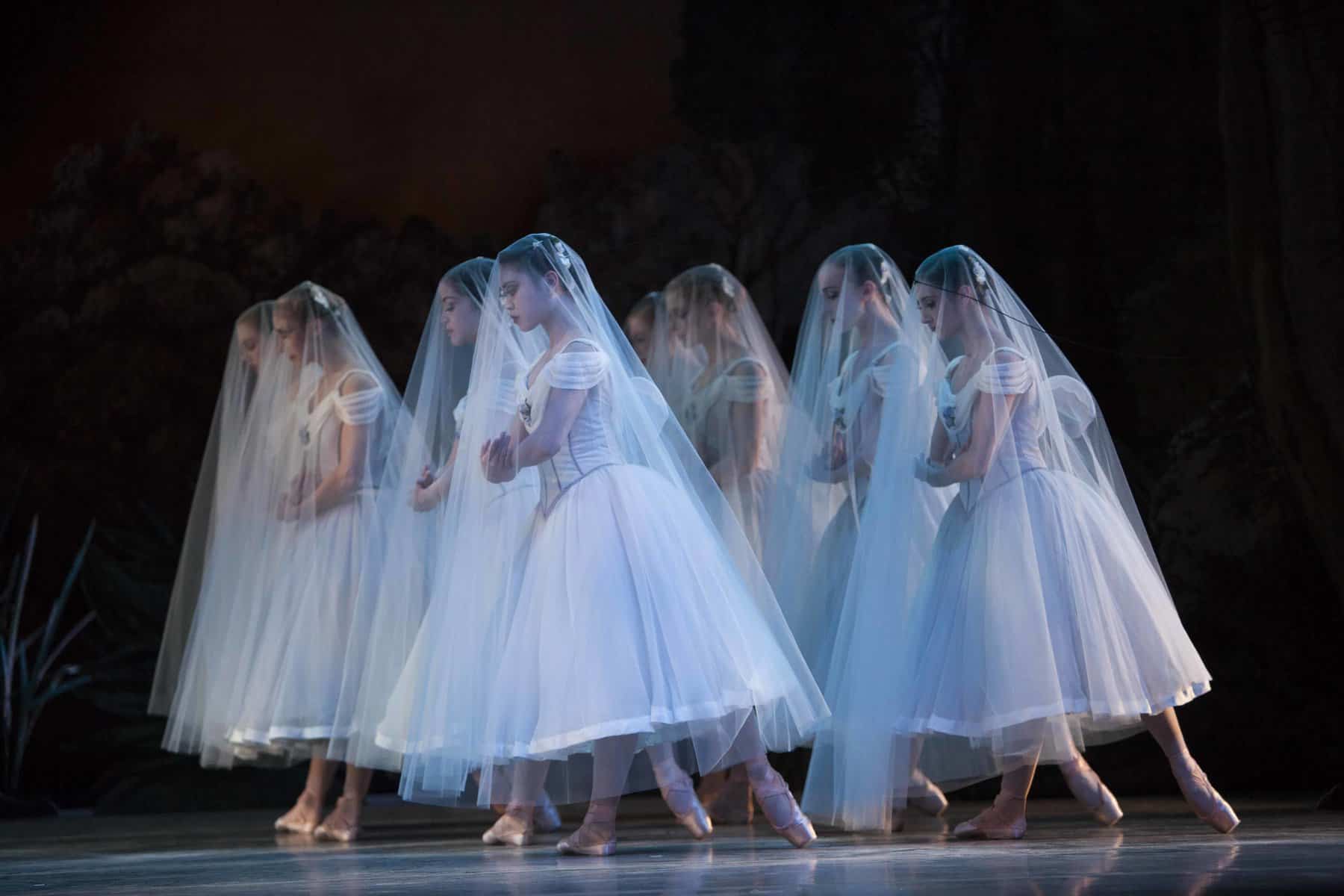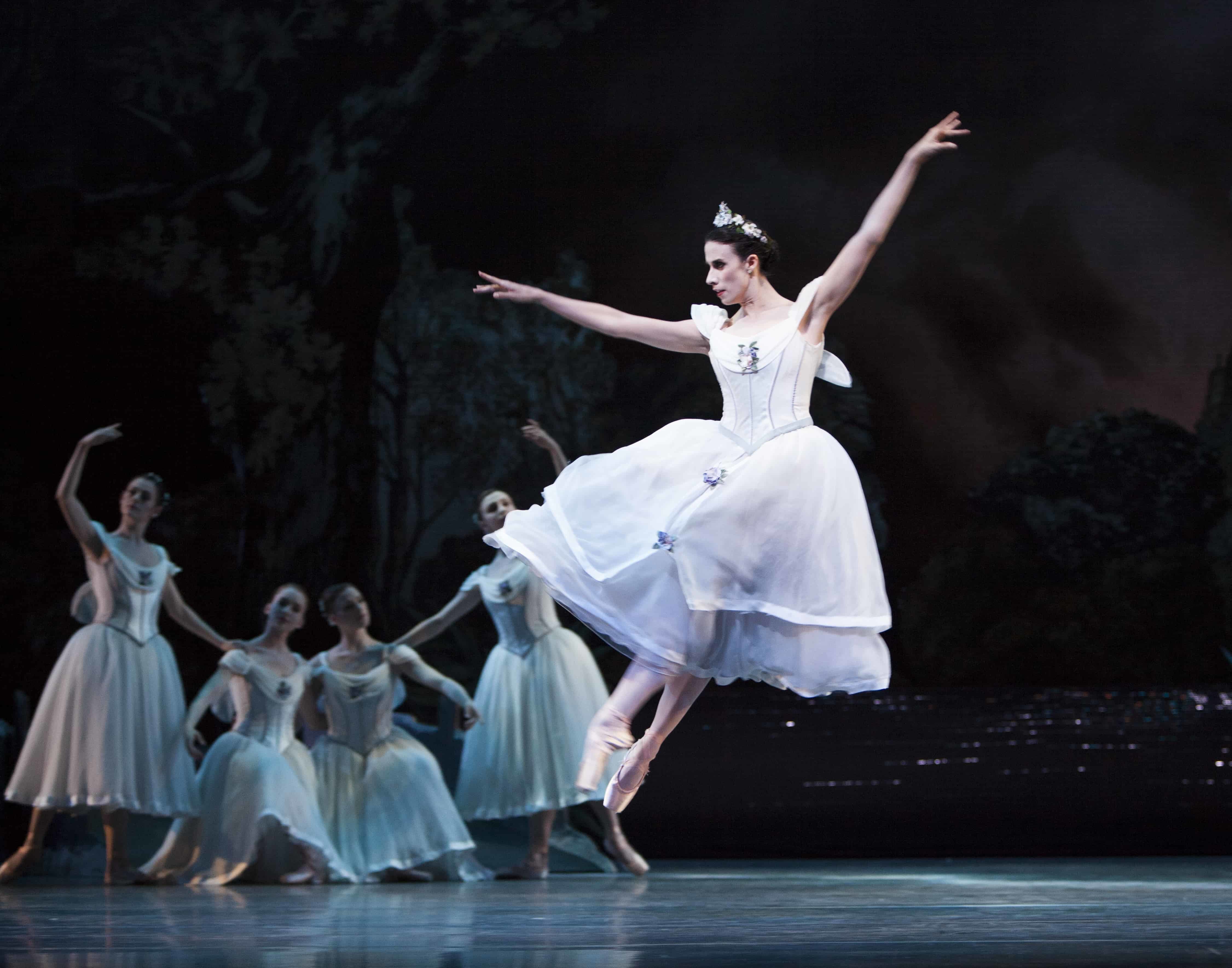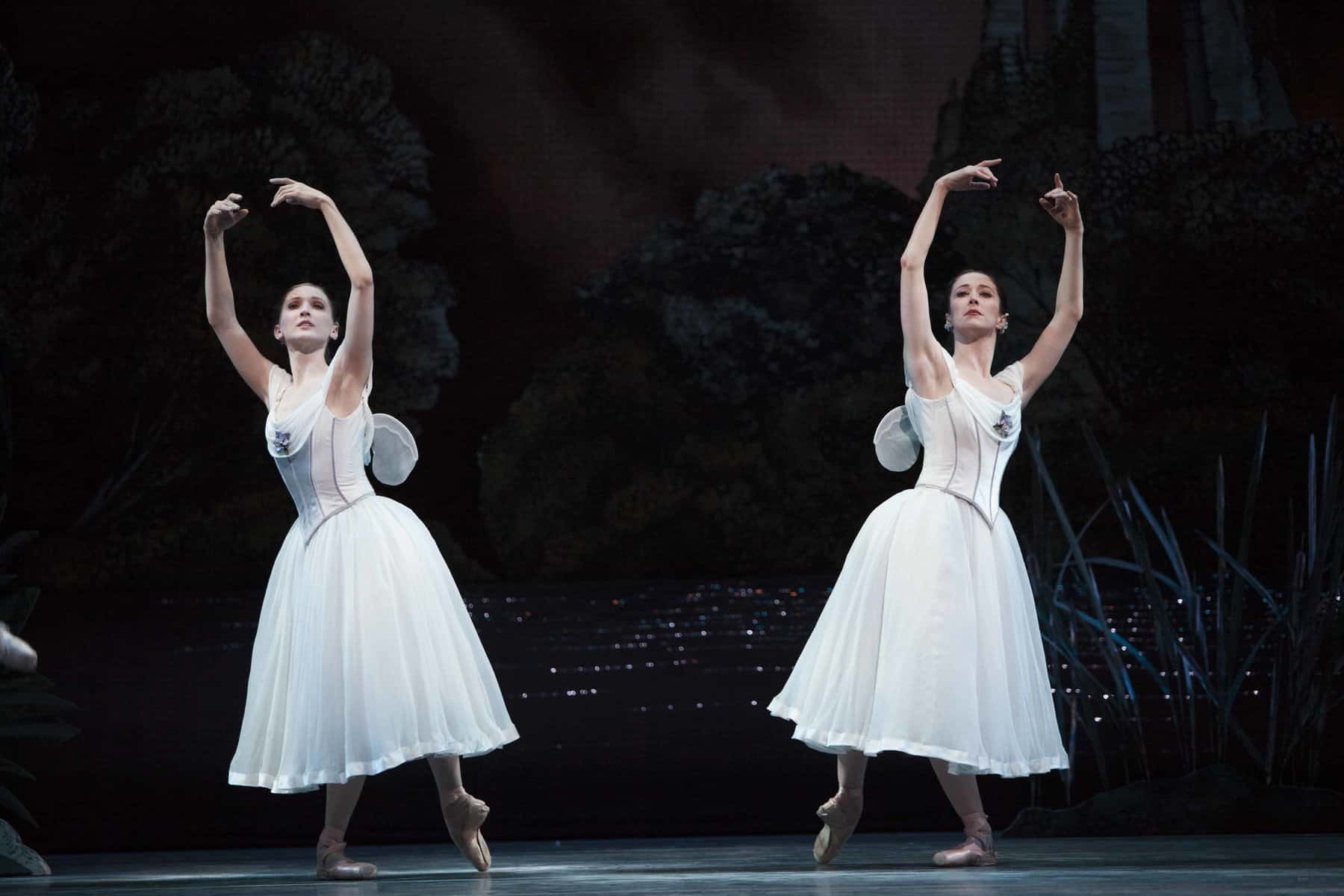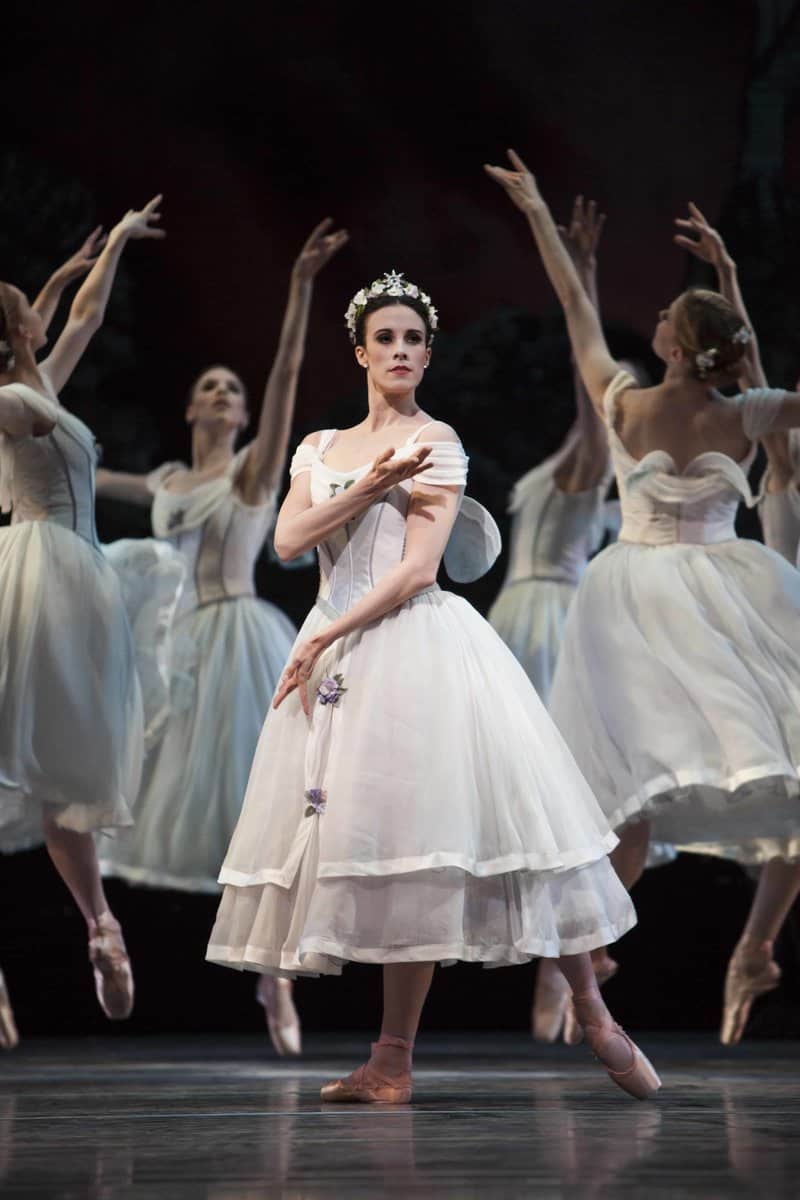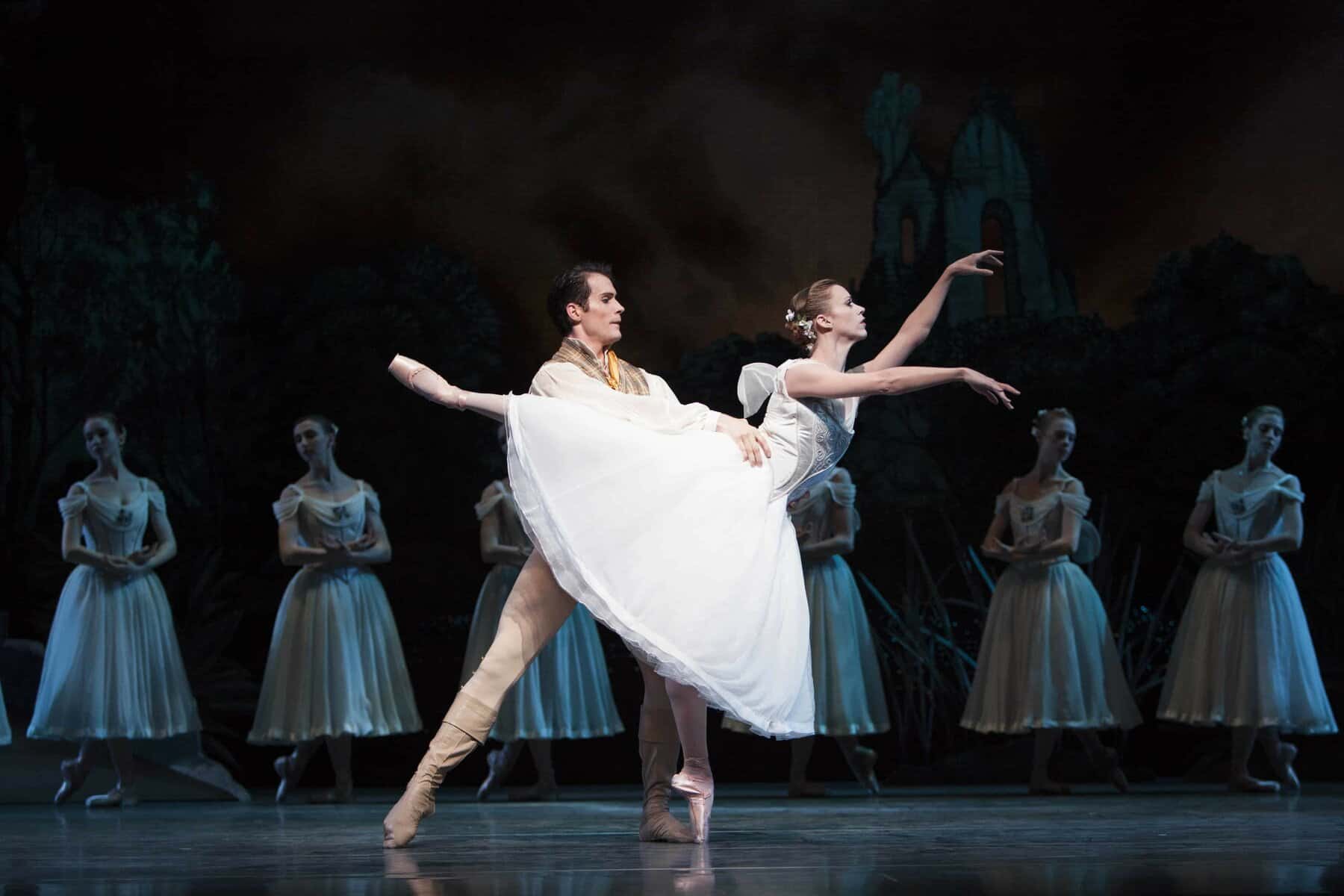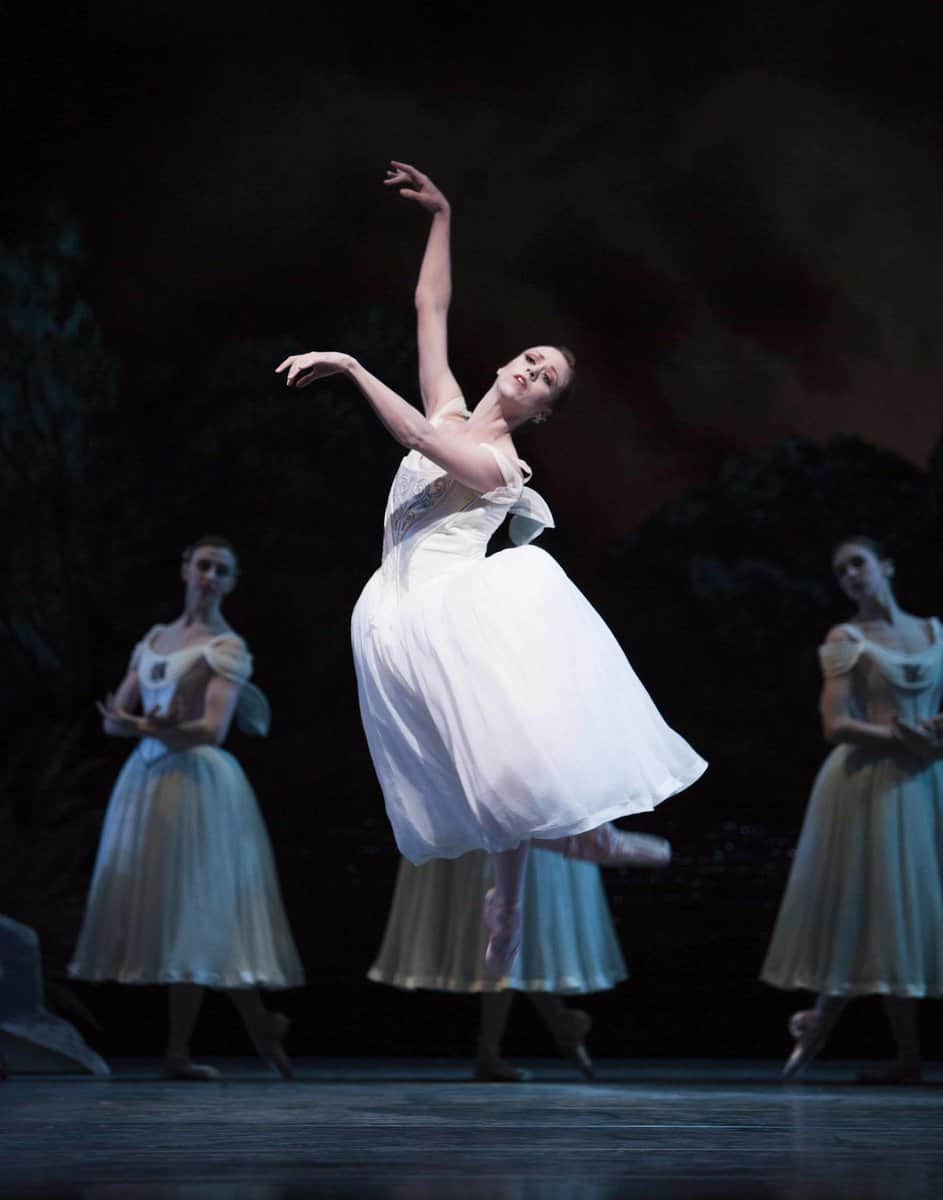Giselle
Libretto
Jules-Henri Vernoy de Saint-Georges and Théophile Gautier
Music
Adolphe Adam (1841), with additional music by Friedrich Burgmüller, Riccardo Drigo, and Ludwig Minkus
Choreography
Jean Coralli, Jules Perrot, and Marius Petipa, with additional choreography by Peter Boal
Staging
Peter Boal
Historical Advisers
Doug Fullington and Marian Smith
Scenic and Costume Design
Jérôme Kaplan
Lighting Design
Randall G. Chiarelli
Original Production Premiere
June 28, 1841; Ballet du Théâtre de l’Académie Royale de Musique (Paris), choreography by Jean Coralli and Jules Perrot
Petipa Production Premiere
February 5, 1884; Imperial Ballet (St. Petersburg), choreography by Marius Petipa (after Jean Coralli and Jules Perrot)
Pacific Northwest Ballet Premiere
Peter Boal production June 3, 2011; new production May 30, 2014
The 2011 world premiere staging of Pacific Northwest Ballet’s Giselle was made possible by Patty Edwards and an anonymous donor. PNB also thanks Dan & Pam Baty, Jeffrey* & Susan Brotman, and Patty Edwards for their leadership support in underwriting new scenery and costumes for the 2014 production of Giselle.
Program Notes
Reviving Giselle
June 2011
Over fifteen months, PNB collaborated with Peter Boal on a new staging of Giselle that utilizes primary source documents, including a repetiteur believed to have been prepared in Paris, circa 1842, a complete notation of Giselle likely made in 1860’s Paris by Henri Justamant, and another choreographic notation made in St. Petersburg, circa 1899–1903. These manuscripts are particularly rich, and one of them has come to light only recently. Taken together, they provide crucial information, about both mime and dance scenes, that has been forgotten over time.
“In Westphalia, the former Saxony, all is not dead which lies buried. When we wander there through the old oak groves we can hear the voices of the olden time, and the re-echoes of those deeply mysterious magic spells in which there gushes a [great] fullness of life …A mysterious awe thrilled my soul—when…wandering through these woods” — Heinrich Heine, On Germany [1833], trans. Charles Godfrey Leland
The idea for Giselle (1841) was inspired by two ghost stories, both read with relish by Théophile Gautier (1811-1872), the colorful balletomane, poet, critic, man-about-town, and staunch defender of Romanticism. One was a poem of Victor Hugo, “Phantoms”, about a beautiful young girl whose love for dancing leads to her demise. This short excerpt offers some sense of its lugubrious, chilling quality:
Dancing caused her death; with eager, boundless love,
Dancing—dazzling, filling her with ecstasies—
And now her ashes thrill and gently move,
When, in a balmy night, white clouds above
Dance round the crescent of the skies.
Gautier’s other literary inspiration was a passage in Heinrich Heine’s On Germany, about Wilis, spectral brides who rise from their graves at midnight to dance beguilingly in the moonlight:
In parts of Austria there exists a tradition … of Slavic origin: the tradition of the night-dancer, who is known, in Slavic countries, under the name Wili. Wilis are young brides-to-be who die before their wedding day. The poor young creatures cannot rest peacefully in their graves. In their stilled hearts and lifeless feet, there remains a love for dancing which they were unable to satisfy during their lifetimes. At midnight they rise out of their graves, gather together in troops on the roadside and woe be unto the young man who comes across them! He is forced to dance with them; they unleash their wild passion, and he dances with them until he falls dead. Dressed in their wedding gowns, with wreaths of flowers on their heads and glittering rings on their fingers, the Wilis dance in the moonlight like elves. Their faces, though white as snow, have the beauty of youth. They laugh with a joy so hideous, they call you so seductively, they have an air of such sweet promise, that these dead bacchantes are irresistible.
Gautier responded to Heine’s words by saying aloud, “What a pretty ballet this would make!” Then (as he recalls):
In a burst of enthusiasm, I … took up a large sheet of fine white paper and wrote at the top, in superb rounded characters, “Les Wilis, a ballet.” But then I began to laugh, and I threw the sheet aside without giving it a further thought, saying to myself, with the benefit of my journalistic experience, that it was quite impossible to transpose onto the stage that misty, nocturnal poetry, that phantasmagoria that is so voluptuously sinister, all those makings of legend and ballad that have so little relevance to our present way of life. That same evening I was wandering backstage at the Opéra with my mind still full of [Heine’s] ideas, when I met that amusing man [Vernoy de Saint-Georges, who had written the stories for successful ballets]… I related the tradition of the Wilis, and three days later the ballet of Giselle was written and accepted. In another week Adolphe Adam had sketched out the music, the scenery was nearly ready, and the rehearsals were in full swing.
Gautier overstates the brevity of the timetable here—the ballet actually took about two months to create. But the Opéra’s director Léon Pillet did indeed push the project along with unusual urgency, hoping to capitalize quickly on the popularity of the ballerina Carlotta Grisi, who had recently caused a sensation dancing in the Donizetti opera La Favorite. And it is true that Vernoy de Saint-Georges, more experienced than his friend Gautier at writing stage drama, helped build an effective plot around a bride-to-be who dies before her wedding day and returns as a ghostly Wili.
The scenario they created is set in Germany sometime in the historical past, its first act taking place in a sunny village, and centering round Giselle and the handsome young man who woos her ardently. In the second act, however, all is plunged into darkness: Giselle, who has died of a broken heart at the end of Act One, now must join the band of vampire-like female ghosts, the Wilis, though she ultimately refuses to follow the cruel commands of the man-hating Wili Queen, Myrtha.
In fashioning the characters and action, Gautier and Saint-Georges incorporated subjects we now recognize as central to much Romantic art and literature: the lives of simple country folk, the historical past, the supernatural, the power of transcendent love, the seeking of the unattainable. They also placed the action in an idealized, locale foreign to France—something typical of French Romantic ballets (though the then-obvious German setting, which was signaled to Parisian audiences by the frequent use of waltz music and the names of the leading couple, is no longer instantly recognizable as such). And they called for ethereal female dancers in long white tutus on a darkened stage, a visual motif that had been popularized by the ballet of the ghostly nuns in the opera Robert le diable (1831) and the white-clad forest-sprites of the ballet La Sylphide (1832), two works that had flourished at the Opéra in the decade leading up to Giselle’s premiere. So it is not hard to imagine whyGiselle was so successful in the era it was first devised.
But why does it remain so popular today? Performed every season by major companies on both sides of the Atlantic and the subject of several popular books, Giselle is also widely available on commercial DVDs, and some of its scenes have even been featured in Hollywood films. How do we account for the continuing success of this ballet? Why is Giselle still so compelling?
One reason is surely the effective way it shows the intrusion of mysterious and alluring-yet-threatening supernatural beings into the lives of everyday mortals—a subject that seems not to have lost its appeal (the recent resurgence of vampire-themed TV shows attests to a spike of interest in this topic at the moment). The encroachment begins in a merely abstract way in Act One: Giselle’s mother Berthe warns the village girls that excessive dancing could lead to their early demise and thus their forced enlistment into the band of Wilis. But Berthe’s description of the Wilis leaves Giselle unfazed and nothing more is heard of these female ghosts for the rest of the act.
Berthe’s words of warning become creepily true, however, in Act Two, which is set on a moonlit night in the Wilis’ territory, a forest glade near a pond. Any mortal male to enter this danger zone does so at his peril. Sure enough, two batches of men do wander in, early in the second act, though they manage to escape quickly. It is another matter entirely for Giselle’s major male characters, however, whose encounters with the Wilis change their lives profoundly and irrevocably.
Every element of the ballet—the choreography, lighting, sets and costumes, and music—help communicate the unfathomable contrast between the real world and the unreal one that lies at the heart of this ballet. The dancing (originally devised by Jean Coralli and Jules Perrot) is in the first act light, airy, carefree, and, in the case of the leading couple, reflective of their lively flirtation. In the second act, however, the range of moods expands greatly, and with it the range of the choreography, which includes, for the Wilis, playful and aggressively vengeful dances as well as drill-team-like formations that demonstrate both their solidarity (sisterhood is powerful!) and obedience to their Queen. And Giselle and Albrecht dance two pas de deux in which the choreography shows the deep and desperate love they have for each other.
The composer Adolphe Adam did his part in conveying the ballet’s central dualism by creating two very different sound worlds, one for each act. The “color” of the first act is bright, mostly in major keys, featuring waltzes and nineteenth-century hoedown music when the villagers dance, and a majestic march for the noble hunting party. (The only dark music in Act One comes up when worrisome thoughts arise momentarily.) In the second act, however, the music creates an appropriately dangerous and uncertain atmosphere, though tinged with a hypnotic feminine sweetness at Myrtha’s first appearance. Adam accomplishes all this—including bringing out the Wilis’ twofold nature—by deploying many more flat-side keys and unstable harmonies than he did in the first act, as well as minor mode, special effects (like muted strings, tremolo, and harmonics), and plenty of lower brass.
Of course the title character Giselle, the very embodiment of the contrast between the real and unreal worlds, surely accounts for much of Giselle’s enduring popularity. She is a sparkly, high-spirited young person whose ghostly return in Act Two as a Wili makes for a stunning character transformation. Giselle is a great ballerina role, and through the generations, it has inspired many famous interpretations—by Pavlova, Karsavina, Spessivtzeva, Alonso, Ulanova, Markova, Fonteyn, Verdy, Fracci, among others—which have become legendary in the annals of the stage.
Though the world has changed radically since 1841, Giselle retains its power, and there can be no doubt that Gautier’s initial idea to make a ballet out of Heine’s Wili story was a good one. Originally wrought through the great teamwork of specialists in music, literature, drama, choreography, and art design, this ballet has been carried forward for well over a century and a half by successive generations of creative artists. Each new performance brings to life anew the spirited young title character and her milieu, and allows audiences today to breathe in the same Romantic air that so inspired Gautier those many years ago.
Notes by Marian Smith.
Photos
Videos
The Story
Act I
As the curtain rises on a picturesque scene in a small German village, vine gatherers depart for the harvest. Hilarion the gamekeeper arrives, hoping to see the lovely Giselle. He hides when his rival Albert-really a Duke disguised as a peasant named Lays-emerges from his cottage, with his squire Wilfride. Wilfride begs Albert not to pursue Giselle, but he ignores this advice and sends Wilfride away. Albert knocks on Giselle’s door; she comes out of her cottage and the two of them delightedly talk and dance together. As they embrace, Hilarion, unable to restrain himself any longer, runs up to Giselle and reproaches her conduct. Giselle reacts disdainfully, and Albert warns him to cease his amorous pursuit of Giselle. Angrily, Hilarion departs.
A troupe of young vine gatherers comes to fetch Giselle, for duty calls-the grapes must be harvested. Giselle, passionately fond of dancing and diversion, talks them into postponing work and dancing instead. Everyone joins together in a merry German waltz. The carefree scene is interrupted by Giselle’s mother Berthe, who comes out of their cottage to scold her daughter: “You are always dancing instead of working!” “What’s more,” Berthe says, “your health is fragile, and if you dance too much, you could die.” As Giselle’s friends gather around, Berthe tells the frightening tale of the Wilis-ghosts of dead brides-to-be who never reached their wedding day-who rise from their graves at night to kill any men who happen by. The crowd is terrified by this story; Giselle alone is unfazed and laughs it off. The fanfares of the hunt are heard in the distance. Albert is worried by this sound, and he quickly hurries the peasant girls away and departs the scene himself. Hilarion, now alone, furtively gains entry to Albert’s cottage in an attempt to find out his rival’s true identity. Soon the noble hunting party, including the magnificently dressed Prince and his daughter Bathilde, arrive in the village, hoping to find a favorable spot for repose and refreshments during the heat of the day. Berthe and Giselle happily oblige. Bathilde finds Giselle charming and engages her in conversation, asking about her work and her pastimes, and asking if she has a sweetheart.
The Prince sends his retinue back to the hunt, informing them that he will summon them with his horn later. After all is quiet, Hilarion emerges from his rival’s cottage holding a nobleman’s sword: he has figured out that his rival is a great lord; a seducer in disguise! He hides the sword, waiting for the right moment to expose the truth about Albert.
Now it is time for the harvest festival. A wagon decorated with flowers comes into view and little Bacchus is carried triumphantly astride a cask in keeping with an old country tradition. Giselle dances with Albert, surrounded by the entire village. The happy scene ends with a kiss that Albert bestows on Giselle.
At this sight, the fury of the jealous Hilarion knows no bounds. He throws himself into the middle of the crowd and declares Albert to be a nobleman in disguise. Giselle responds with disbelief. But Hilarion produces Albert’s sword for all to see. He then seizes the horn and blows it forcefully, summoning the entire hunting party, which comes rushing in. The nobles recognize Duke Albert and overwhelm him with salutations and deference.
Giselle can no longer doubt Albert’s deception. She is devastated, and goes mad. She recalls her happy times with Albert, seizes his sword, and nearly kills herself before he grabs it away. Life seems to abandon her; her mother takes her in her arms, and moments later, Giselle dies. Albert tries to revive her, but sees that her heart has ceased to beat. He is consumed with despair as the peasants and noblemen gather sorrowfully around Giselle’s lifeless body.
Act II
The curtain opens in a dark and gloomy forest on the banks of a pond. Giselle’s tombstone can be seen at the left; the bluish gleam of the moon gives a cold and misty appearance to the scene. Several gamekeepers arrive, hoping to set up an observation post, but Hilarion warns them away: this is the place where the Wilis gather at night, attacking any men who stray into their territory, drowning them or forcing them to dance themselves to their death. Distant chimes strike midnight-the hour when the Wilis appear-and the men flee in terror as will-o’-the-wisps flash threateningly around them.
Myrtha, the queen of the Wilis, arrives on the scene, mysteriously radiant and piercing the shadows of the night. She summons the other Wilis to join her in a fantastic ball. The Wilis, including Moyna and Zulme, present themselves to their sovereign, and soon all of the Wilis are waltzing with abandon, gratifying their love for dancing which they were unable to fulfill in life. Before long, at a sign from the queen, the dance comes to an end, and Myrtha announces the arrival of a new Wili.
Giselle appears, rising from her grave, wrapped in a shroud. When Myrtha touches her with her rosemary branch, the shroud falls off and Giselle is transformed into a Wili. She dances with fervor until a sound is heard in the distance. The Wilis disperse and hide themselves.
Some youths are returning from a festival in a neighboring village. The Wilis seek to detain them and try to force them to dance. However, an old man throws himself in their midst and warns them of the danger; they barely escape, with the Wilis in hot pursuit.
The grief-stricken Albert appears with his faithful squire, Wilfride. Though Wilfride begs Albert not to linger near the fatal tomb, Albert sends him away. Soon thereafter, Albert, in his state of sorrow, believes he sees the ghost of Giselle. He tries to embrace her, but he cannot. She looks at him lovingly and throws him some roses. Giselle disappears back into her tomb. Albert is about to depart the scene when he sees Hilarion.
Hiding behind a tree, Albert watches as the poor hapless gamekeeper, frightened nearly to death and begging for pity from the Wilis, is forced to dance himself to exhaustion. The cruel Wilis throw him into the pond and then begin dancing amongst themselves.
Then, to Albert’s horror, Myrtha spots him in his hiding place: a fresh victim! Desperately, he tries to escape, for he knows what cruel fate awaits him. But Giselle re-appears miraculously, takes him by the hand, and leads him to her tombstone, a marble cross, which holds a power even stronger than that of the Wilis. Just as Myrtha is about to touch him with her scepter, it breaks in her hands. Myrtha is furious at her loss of power.
As a last resort, and seeking revenge on the Wili who robbed her of her prey, Myrtha extends her hand toward Giselle and casts a spell on her. Giselle begins a slow, graceful dance, as though transported by an involuntary delirium. Albert is unable to resist the Wili Giselle and he leaves the cross-the only thing that could protect him-and begins dancing ardently with her. Giselle has no choice but to keep dancing, for she is under Myrtha’s spell. Albert becomes exhausted.
Just as it seems Albert will dance himself to death, the first rays of the sun appear. It is morning! The chimes strike four. Albert’s life is saved. Because the Wilis lose their power in daylight, they must withdraw. Giselle, too, must return to her grave. Albert kneels by her and gives her a kiss, as if to restore her to life, but Giselle seems to say that she must obey her fate and leave him forever. Suddenly, loud fanfares are heard; Wilfride, the faithful squire, arrives on the scene with the Prince and Bathilde, whose efforts, he hopes, will be more effective than his own in persuading Albert to leave this place of sadness. Giselle points Albert toward Bathilde, as if to tell him it is her last wish that he marry the young noblewoman. Albert is heartbroken, but the Wili’s command to him seems sacred. With sorrow, Albert gathers up the flowers on her grave and lovingly presses them to his lips and to his heart. As he falls into the arms of those who surround him, he reaches out his hand to Bathilde.
Sources
The Titus manuscript. According to the Theatre Museum in St. Petersburg—where it is housed today— this 156-page manuscript (for violin and cello) was brought to Russia in 1842 by the ballet master Antoine Titus to aid him in the staging of Giselle in that city. Its great value lies in its copious annotations (in French), which describe the mime scenes, showing specifically how the action matched up to the music. For instance, in Hilarion’s opening solo mime scene, the annotations tell us that “he points to Giselle’s house and says ‘here lives the one I love’” as sweet music is played softly for eight counts. Then “he makes a gesture of menace and approaches Loys’ house” for the succeeding eight counts, in which the music is loud and dissonant.
Such annotations disclose not only what music and mime were intended for each other in Giselle in particular, but also open the door to understanding in general how composer and choreographer worked in complementary fashion to create Parisian ballets of this era. Indeed, every note, every phrase, every shift from loud to soft or major to minor is designed to provide the dancers with a vital resource for communicating the drama, moment to moment—a resource that is not always recognized today as such.
The Justamant manuscript. Some twenty years after the Titus manuscript was created, another ballet master, Henri Justamant (sometimes spelled “Justament”), came up with his own Giselle staging manual: a 236-page document with detailed prose descriptions (in French) of the dancing and mime scenes, illustrated with hundreds of drawings in an easy-to-decipher choreographic notation based on stick figures (men in black ink, women—and will o’ the wisps!—in red ink). Remarkably, this manuscript turned up at a flea market in Regensburg in 2002, and is now in the collection of the Deutsche Tanzarchiv Köln. It was published in facsimile by Frank-Manuel Peter (Georg Olms Verlag) in 2008.
The Stepanov manuscript. The Harvard Theatre Collection at Harvard University houses the Sergeev Collection of dance notations and musical scores mostly representing the repertory of the Imperial Theatre in turn-of-the-century St. Petersburg. The collection contains several items relating to Giselle: a choreographic notation of the ballet made in the Stepanov method, a separate choreographic notation of the so-called “Peasant pas de deux,” a manuscript orchestral score, an annotated published piano score, a prose description of the action of Act One, and various performance programs. The notation can be dated approximately 1899-1903, based on Anna Pavlova’s performance history in Giselle because her name is included in the notations of both acts—as Giselle in Act One (Pavlova first danced the title role in 1903) and the Wili Zulmé in Act Two (first performed in 1899).
The production represents French choreographer Marius Petipa’s version of Giselle that was based on the original Paris production, choreographed by Jean Coralli and Jules Perrot. The Stepanov notation of Giselle was used in the West for historic stagings by Paris Opéra Ballet and the Vic-Wells Ballet (now the Royal Ballet).
The choreographic notation includes mostly lower-body movements, with few indications for torso, head, and arms. Ground plans indicate blocking, and Russian prose describes action as well as mime scenes. When compared to the earlier French sources, the Stepanov notation offers more choreographic detail and the possibility of aligning dance and music with a fairly high degree of accuracy. Conversely, it offers fewer prose details of action, and the action described is delivered in coarse, blunt prose.
Familiar and Unfamiliar
The French manuscripts give us a marvelous opportunity to discover ways in which this ballet was performed in the first two decades of its existence, that is, before Petipa created his now-famous version of Giselle in St. Petersburg in 1884—the version that today’s productions are based on. They reveal, quite surprisingly, that Petipa’s version of the choreography was not nearly as different from that of Coralli/Perrot as dance historians have long averred. Passages in the Justamant manuscript that are choreographically similar to those in the Stepanov manuscript include many elements in the Act One Scène d’amour, sequences of steps in the Peasant pas de deux, Giselle’s first entrance in Act Two, as well as the opening of that act’s adagio for Giselle and Albrecht, and the well-known diagonal formation of the Wilis It seems that Petipa liked much of what he saw in the original choreography and kept it.
At the same time, the manuscripts disclose several features of Giselle quite unlike what we are accustomed to now. We shall mention three of these briefly.
First, the French manuscripts show that action in many cases laps over from one scene to the next, presumably to keep the pace lively. For example, before Berthe can persuade Giselle to return to their cottage at the end of Act One scene vi (Berthe’s scene) village girls hearken to the sound of hunting horns and dash across the stage, helping the audience to anticipate the imminent arrival of the hunting party.
Second, the French manuscripts reveal a bit of levity toward the beginning of the second act. First, some cheerful gamekeepers enjoy a drink or two from their gourds after wandering unknowingly into the Wilis’ territory, before being warned away by Hilarion and frightened by will o’ the wisps (Act Two i, ii); then a few scenes later, after the audience has been introduced to the Wilis, another group of mortal men happens by (in the Titus manuscript), this time young men returning from a festival in a nearby village, accompanied by an old man who recognizes dire danger when Wilis appear and strike “voluptuous poses” (as the libretto puts it) (Act Two vi). Louis Petit, who played the old man in the original production of 1841, was known for his comic acting, and likely made the most of this small role. In any case, the presence of these scenes (peopled by rustics, whose DNA on the 19th-century French stage was likely to carry a comic strain) were quite in keeping with custom at the Paris Opéra, where light scenes often leavened serious operas and ballets, and made the emotional range of the second act of Giselle a bit broader than it has become in modern productions.
Third, these sources show us characters whose personalities are not quite the same as the ones we are accustomed to—for instance, this Giselle is more high-spirited and feistier. Indeed, in Act One scene iv when Loys fails to appear on time she says (in the Justamant manuscript) “Loys should have come; but he isn’t here; he’s badly behaved and I’m leaving.” When he arrives shortly thereafter, she turns her back on him, saying to herself, “There he is. He will pay me back.” This is a far cry from the emotionally delicate girl we sometimes encounter today in this scene, a girl who seems dependent on Loys’ affection for her sense of well-being and even weeps a few minutes later when the daisy-petal prognostication comes out badly. (This weeping is not mentioned in either of the French manuscripts.) Giselle also openly defies her mother in Act One scene vi and even tries to dance away with Loys at the end of the scene, and in the finale of the same act (in the Justamant manuscript) actually curses Loys. The strength of Giselle’s spirit in the first act helps explain how she is able to defy in Act Two of the most formidable character of all: Myrtha.
Finally, it must be pointed out that both the Justamant and Stepanov manuscripts confirm, rather unsurprisingly, that the dance vocabulary of the time was primarily petit allegro—small, fast steps, primarily jumps and beats—for both men and women, soloists and corps de ballet. Moreover, in the Stepanov manuscript, all women in dancing roles wear pointe shoes.
Working Process
Marian Smith (mime and action scenes as notated in the two French manuscripts): My first task was to translate from the French and enter all of the texts of the mime scenes (and those dance scenes entailing dramatic action) from the two French manuscripts into my ‘master score,’ the piano reduction prepared by Lars Payne, who also edited the full score from the autograph and other Parisian manuscripts. (Lars is well acquainted with the productions of Mary Skeaping, whose re-discovery of the original musical score in Paris in the 1950s was reflected in her highly regarded production of Giselle for the London Festival Ballet in 1971). Then, after workshopping a few scenes from Act One in my graduate class (at the University of Oregon) on 19th-century staging practices for operas and ballets, I turned to my longtime collaborator Lisa Arkin (a dancer, choreographer, and dance historian). Scene by scene, after listening intently to the music (specifically, the recording by Richard Bonynge), we discussed at length the characters’ motivations and personalities as the manuscripts and the music conveyed them, and she acted most of them out accordingly, setting the tone for the characters’ moods and devising gestures when actions outside the usual mime vocabulary were called for (as when Giselle at the end of Act Two tells Albrecht: “forget me and go to the one you must marry”). Before embarking for Seattle, I videotaped several of these scenes as performed by Lisa and Dawn Urista, a UO graduate student.
The ideas (and video excerpts) I presented to Peter were, of course, raw material and not a finished product. In many cases, Peter and the rest of the creative team (Doug Fullington and the Pacific Northwest Ballet dancers) made adjustments. Rehearsals have been characterized by genial back-and-forth discussions, a bit of trial and error, and like the ballet itself, levity—Peter refers to me as “France” and Doug as “Russia.”
Doug Fullington (choreography as notated in the Stepanov manuscript): My colleague Kaleriya Maslyak provided me with translations of the Russian prose in the manuscript while I deciphered the Stepanov notation symbols. I was then able to prepare duplicate pages of the notation score that include English translations of the Russian and descriptions of the choreography, as well as clarification of the blocking, among other information. Next, I determined which bars of music relate to particular passages of choreography. From there, Peter Boal and I workshopped the choreography with individual dancers, filming our results for later evaluation before Peter staged final versions.
* * * * *
As of this writing, we are just about to enter our final concentrated rehearsal period that will lead us to the premiere of this new Giselleon June 3 in Seattle. Our goal is not to reconstruct any one version of Giselle, but to create a version informed by early sources in order to refresh and rediscover this still great and beloved ballet.
Essay by Marian Smith and Doug Fullington.
Acknowledgements
The original score by Adolphe Adam for Giselle has been edited by Lars Payne using original sources provided by the Bibliothèque nationale de France (Departement de Musique), the Bibliothèque de l’Opéra, and the British Library.
An 1842 manuscript rehearsal score with annotations in French has been made available by the Theatre Museum, St. Petersburg.
Imperial-era documents relating to Giselle have been made available by the Harvard Theatre Collection, Harvard University, including a choreographic notation of Giselle in the Stepanov notation system, an Imperial-era orchestral score, a printed piano score with manuscript interpolations, and additional materials.
The Russian prose in the Stepanov choreographic notation and other Imperial-era documents has been translated by Kaleriya Maslyak.
Lisa C. Arkin worked closely with Marian Smith and contributed significantly to the devising of the mime scenes.
We thank the students of MUS 607 (Seminar on 19th-century Staging) at the University of Oregon, especially Dawn Urista, for workshopping the mime scenes in Act One of Giselle with Marian Smith.
We thank Elizabeth Cooper (Director, Dance Program) and the students of Dance 401A (Advanced Ballet) at the University of Washington for workshopping the ensemble dances in Act One of Giselle with Doug Fullington.

